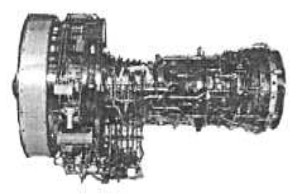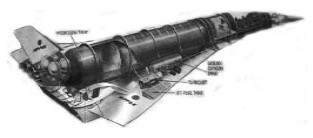Updated: 08-Oct-2020
The "National Aerospace Laboratory" was a governmental establishment dedicated to aeronautical research and development.
-Jointly with MITI (Ministry of Industry) and IHI they made a turbofan engine of more than 11,000 lbf of thrust, known as the FJR / 710.

“NAL, FJR/710”
-This gave way to improved versions such as -720 and -722.
-The FJR / 720-600S was the most tested. It is a double shaft turbofan engine.

“NAL, FJR/720-600S”
From Appendix 6: Scramjet engine trials were also carried out in Japan, specifically at the National Aerospace Laboratory (NAL).
-They were built by Mitsubishi Heavy Industries with an estimated power of 15 tons of thrust. With a concept similar to the American X-30.

"The Japanese spaceship"
-The engines used for flight at high Mach, between 5 and 20, are LACE or Liquid-Air Cycle Engines, for low speed and high speed thrusts.
-For take-off it uses conventional turbines and for orbital maneuvers it has rocket engines, mainly in the tail.
-The Scramjet engine is the rectangular box under the spaceship, at the rear.
From Appendix 11: In 2003 NAL merged with ISAS and NASDA to form JAXA
Engines of NAL
Model: FJR-710
Arquitecture: Turbofan
Compressor/s:
Combustion chambers:
Turbines:
Power / Thrust: --- / 11000 Lbf
Weight:

"NAL, FJR/710"
Model: FJR-720
Arquitecture: Turbofan
Compressor/s:
Combustion chambers:
Turbines:
Power / Thrust:
Weight:

"NAL, FJR/720-600S"
Model: LACE
Arquitecture: Scramjet
Chambers:
Fuels:
Feed System:
Ignition:
Thrust:
Weight:


